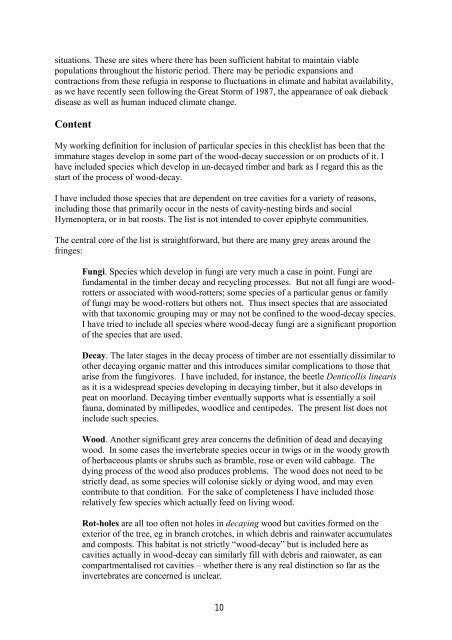Crustacea: Copepoda - Cerambycoidea.com
Crustacea: Copepoda - Cerambycoidea.com
Crustacea: Copepoda - Cerambycoidea.com
Create successful ePaper yourself
Turn your PDF publications into a flip-book with our unique Google optimized e-Paper software.
situations. These are sites where there has been sufficient habitat to maintain viable<br />
populations throughout the historic period. There may be periodic expansions and<br />
contractions from these refugia in response to fluctuations in climate and habitat availability,<br />
as we have recently seen following the Great Storm of 1987, the appearance of oak dieback<br />
disease as well as human induced climate change.<br />
Content<br />
My working definition for inclusion of particular species in this checklist has been that the<br />
immature stages develop in some part of the wood-decay succession or on products of it. I<br />
have included species which develop in un-decayed timber and bark as I regard this as the<br />
start of the process of wood-decay.<br />
I have included those species that are dependent on tree cavities for a variety of reasons,<br />
including those that primarily occur in the nests of cavity-nesting birds and social<br />
Hymenoptera, or in bat roosts. The list is not intended to cover epiphyte <strong>com</strong>munities.<br />
The central core of the list is straightforward, but there are many grey areas around the<br />
fringes:<br />
Fungi. Species which develop in fungi are very much a case in point. Fungi are<br />
fundamental in the timber decay and recycling processes. But not all fungi are woodrotters<br />
or associated with wood-rotters; some species of a particular genus or family<br />
of fungi may be wood-rotters but others not. Thus insect species that are associated<br />
with that taxonomic grouping may or may not be confined to the wood-decay species.<br />
I have tried to include all species where wood-decay fungi are a significant proportion<br />
of the species that are used.<br />
Decay. The later stages in the decay process of timber are not essentially dissimilar to<br />
other decaying organic matter and this introduces similar <strong>com</strong>plications to those that<br />
arise from the fungivores. I have included, for instance, the beetle Denticollis linearis<br />
as it is a widespread species developing in decaying timber, but it also develops in<br />
peat on moorland. Decaying timber eventually supports what is essentially a soil<br />
fauna, dominated by millipedes, woodlice and centipedes. The present list does not<br />
include such species.<br />
Wood. Another significant grey area concerns the definition of dead and decaying<br />
wood. In some cases the invertebrate species occur in twigs or in the woody growth<br />
of herbaceous plants or shrubs such as bramble, rose or even wild cabbage. The<br />
dying process of the wood also produces problems. The wood does not need to be<br />
strictly dead, as some species will colonise sickly or dying wood, and may even<br />
contribute to that condition. For the sake of <strong>com</strong>pleteness I have included those<br />
relatively few species which actually feed on living wood.<br />
Rot-holes are all too often not holes in decaying wood but cavities formed on the<br />
exterior of the tree, eg in branch crotches, in which debris and rainwater accumulates<br />
and <strong>com</strong>posts. This habitat is not strictly “wood-decay” but is included here as<br />
cavities actually in wood-decay can similarly fill with debris and rainwater, as can<br />
<strong>com</strong>partmentalised rot cavities – whether there is any real distinction so far as the<br />
invertebrates are concerned is unclear.<br />
10

















